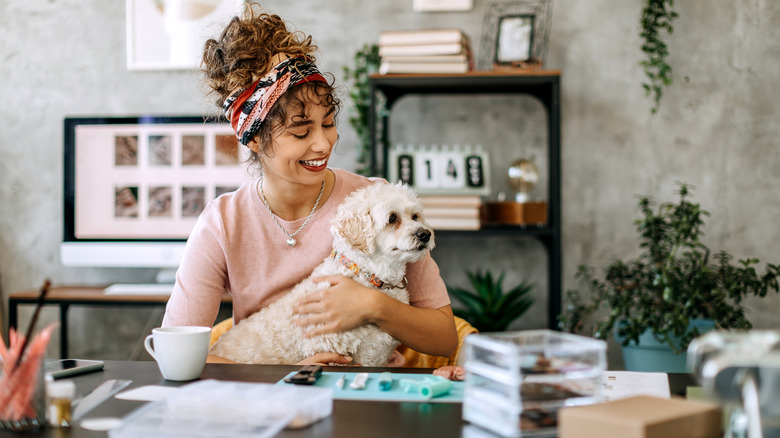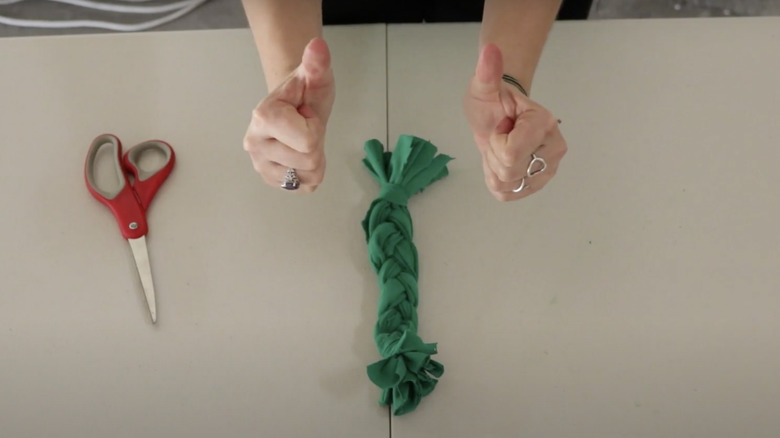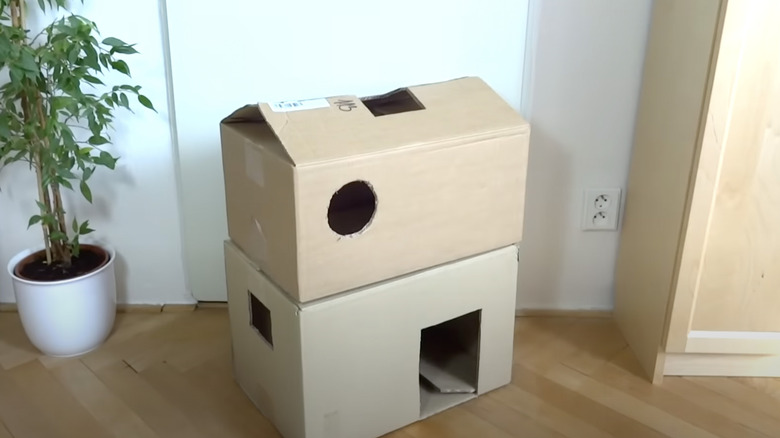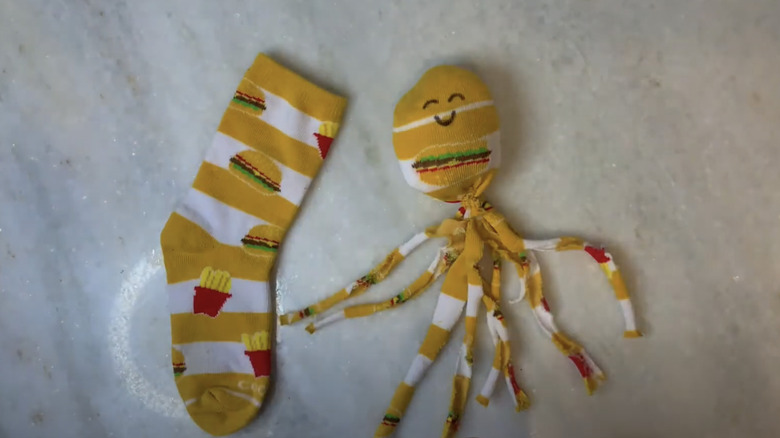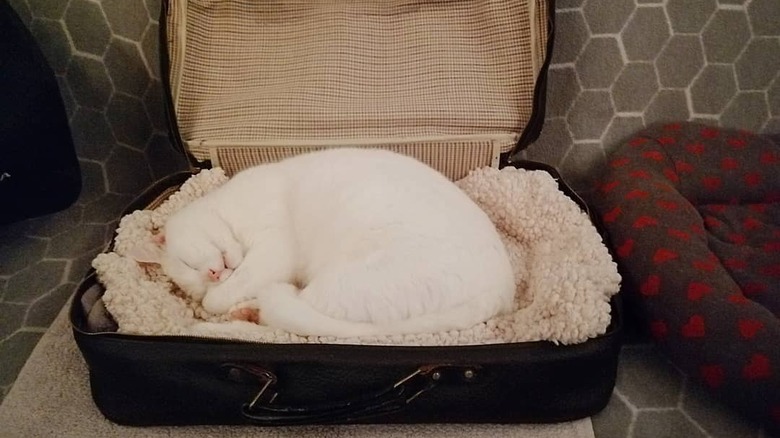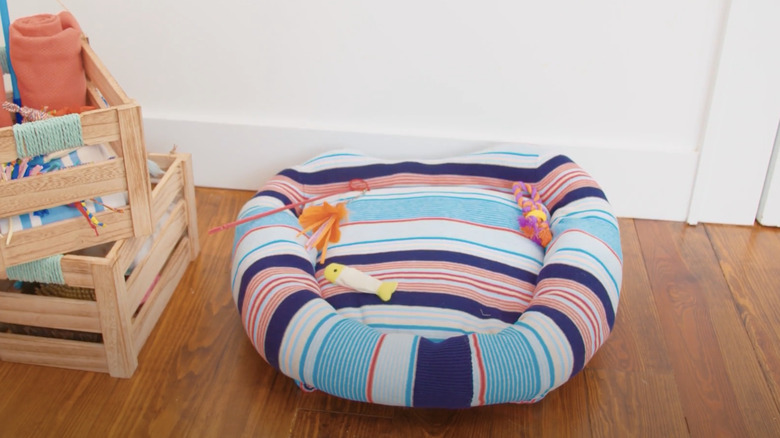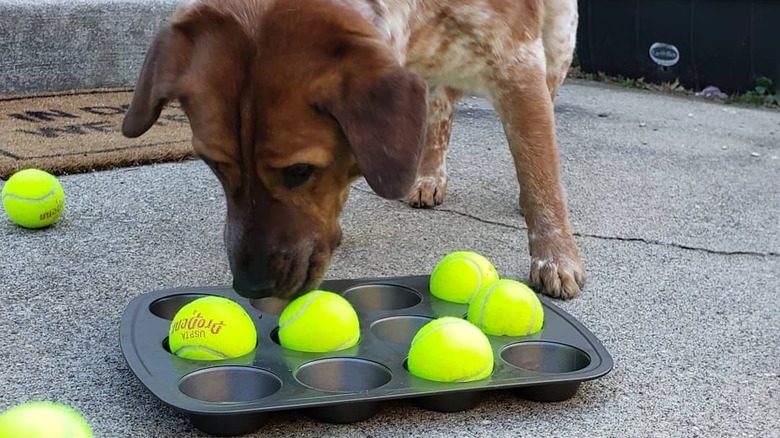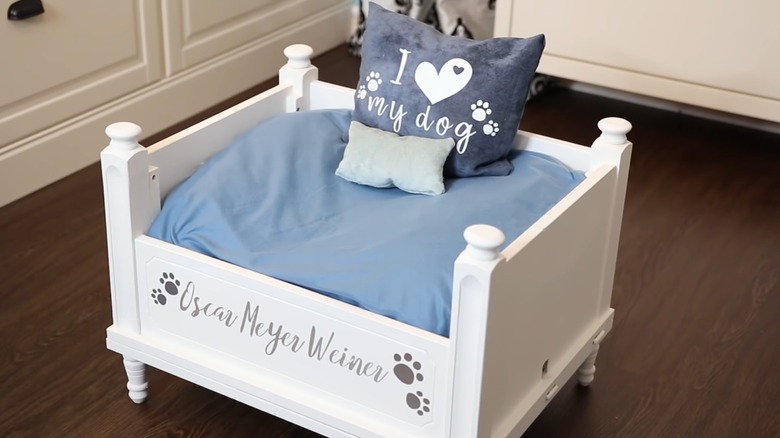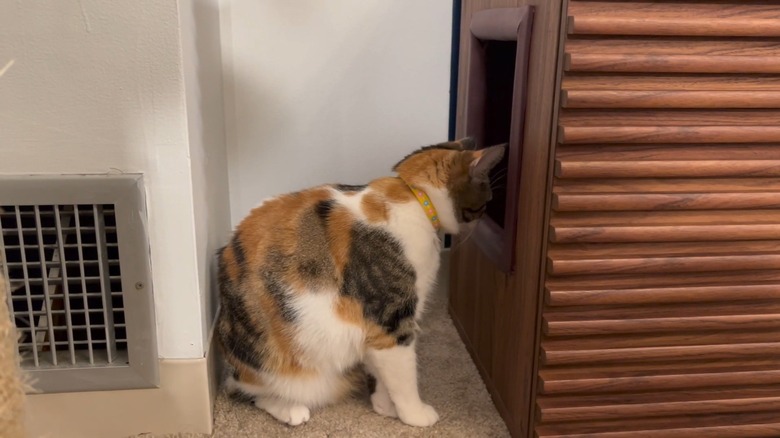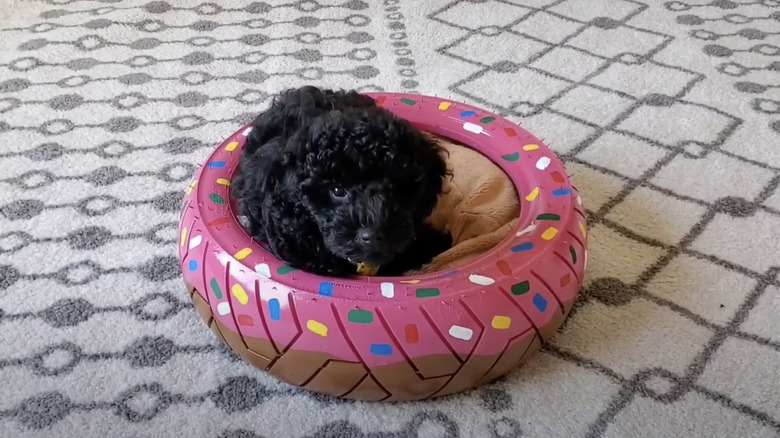Old Items Around Your Home That You Can Repurpose For Pets
We may receive a commission on purchases made from links.
We all know that pets are costly additions to any home. According to the American Society for the Prevention of Cruelty to Animals (ASPCA), the average annual cost of a dog was $1,391 and $1,149 for cats as of 2021. Although this is small change for some, many people need to make a few financial sacrifices to provide their pets with everything they need. One way to lower costs is by repurposing old items around your home that you no longer need and transforming them into something new and exciting for your pet. Not only can this turn into a new, creative hobby for you, but you'll be reducing waste and lowering demand for new resources.
Some repurposing jobs will be incredibly simple to pull off, while others may challenge your DIY skills. Have fun with each project you take on and modify them according to your abilities and creativity while keeping your furry friend in mind. After completing these DIYs, your pet will have a new box of toys, and you'll have much less clutter lying around your home!
Toilet paper rolls
Most households are left with at least one empty toilet paper roll on a regular basis. Instead of throwing this item into the dustbin, turn it into a new toy for your pet. These playthings won't be long-lasting because of the material they're made from, but they're so easy to repurpose that you can do it every week.
If you've got tissue paper, place a few of your pet's treats inside, scrunch it up, and push it down into a toilet paper roll. Alternatively, cut a hole into the side of a toilet paper roll that is big enough to fit your pet's treat through, add some crunchies, and fold the open sides to secure them inside. Now you've got a soft dispenser toy! If you don't have any extra materials, that's fine too! Your pet will have plenty of fun just chewing on the empty roll and listening to the noises it makes.
If you've got a pile of empty toilet paper rolls, you can use them to create an enrichment activity for your pet. Enrichment matters for cats and dogs because it prevents boredom, encourages problem-solving, and builds confidence. Stand all the toilet paper rolls up inside a cardboard box and scatter treats inside. Your pet will rummage through all the obstacles to get to the tasty morsels.
Old T-shirts
If your pet is licking inflamed skin or an incision, you need to stop them so the area can heal properly and not become infected. An Elizabethan collar will be necessary for pets who lick excessively so they cannot reach the sensitive area. If your veterinarian isn't open or is waiting on new stock, an old T-shirt can be a temporary solution to protect the spot. It'll probably be too big for your pet and drag on the floor, so gather it up and tie the leftover material into a knot above your pet's waist.
T-shirts can also be torn apart to create a fun and durable DIY rope toy ideal for tug-of-war. You'll need to rip the old T-shirts into three long strips and two shorter strips. Tie the long strips together with one of the short strips and then braid the long strips. Once you've reached the end, use the other short strip to tie the bottom of the braid so it doesn't come undone.
Cardboard boxes
When it comes to cardboard boxes, your options are endless. They're great for storing pet items and are a lifesaver when moving. Cats love to curl up in boxes because they have a den-like feel, making them feel safe, warm, and secure. They're also fun for felines to explore. Dogs tend to be less sentimental about cardboard boxes and are more likely to chew and rip them to shreds. If you're happy to clean up hundreds of little cardboard pieces, you've got yourself a toy that your dog will be busy with for hours. However, make sure to supervise your pooch during these sessions and tidy up right away, as eating cardboard can lead to intestinal blockages.
You can make a DIY cardboard house for your feline by turning it upside down and cutting a doorway into the side. You can even create an epic DIY cat castle or a two-story home by cutting a hole into the roof of the bottom box and gluing another cardboard box on top. This will allow your kitty to move between the levels. Just ensure it's free of any staples or loose sticky tape that they could chew on or swallow.
Every new addition needs a pet-friendly safe space sectioned off from other areas of the house that may contain electrical wires, choking hazards, and toxic houseplants. However, you'll need a barrier or pet gate to stop them from running into these danger zones. You can set up a makeshift pet gate by breaking down a cardboard box, stretching it out, and securing it upright with chairs or whatever else you have in the room. It probably won't hold up against the force of larger dogs, but it'll work fine for young or small pets.
Plastic bottles
So many food items and liquids are packaged in plastic bottles. You can recycle these by turning them into DIY treat dispenser toys for your pet. This is one of those really easy projects that takes little time to make but provides your pet with a whole lot of fun! Take your bottle and cut a hole into the side that is big enough to fit your pet's treats through. You can then open the cap, pour treats inside, and put the cap back on. Well done, you've turned your waste into a dispenser toy!
It's no secret that most dispenser toys are expensive. For example, the KONG Wobbler is almost $20 on Amazon. Your DIY version definitely won't be as durable and long-lasting as KONG products, but it will provide your pet with the same mental stimulation because they'll still have to figure out how to get the treats out. It will also help them eat slower, which is good for digestion, and release their pent-up energy.
Bear in mind that you should never let your cat or dog play with a plastic bottle unsupervised. Chewing on them can lead to internal blockages. It's also crucial to ensure the holes you create in the bottle don't leave behind any sharp edges that could cut your pet's mouth.
Socks
Believe it or not, socks are an important item to keep in your first aid kit. You can put washed socks on your pet's paws if they develop hot spots from excessive licking due to pain or itchy skin. The sock won't heal the hot spot, but it will protect it so your pet can't make it worse.
For a fun alternative, use old (clean) socks to construct fun toys for your animal companion. To make a catnip toy, stuff a sock with cotton balls and sprinkle some catnip inside. Secure the sock by tying the open end into a knot or with a strip of fabric. Cats love catnip because the substance on it causes their bodies to release endorphins. These "feel good" hormones can lead to temporary behavior changes in your cat, such as affection and playfulness. They can also help them feel relaxed, so add this DIY to your list of cat-calming home remedies and bring it out for your feline to play with during stressful situations.
For other pets, make a DIY sock octopus. Put cotton balls into the toe of the sock and tie it off with a knot. Cut the remaining material into strips coming from the knot. You can leave these strips to dangle or make them more durable by tying every three strips into a braid. Whether you go the catnip or octopus route, only allow your pet to play with these sock toys under your watchful gaze to ensure they don't rip them apart and eat the cotton balls within, which could result in a blockage or other internal issues.
Doormat and frame
Cats need to scratch for a number of emotional and physical reasons. It's one way they release big emotions and maintain their nail health. If you don't have cat scratchers around, your furniture will take on the role, which is costly to fix and may leave you feeling frustrated. This isn't "naughtiness" on your cat's part; they're simply meeting a need.
You can deter your pet from scratching your furniture by offering an old doormat to let loose on instead (as long as it's free of potentially dangerous substances or debris and made from a cat-safe material). Your cat will be more drawn to it if it is standing upright instead of flat on the floor, so you can use an old photo frame to hold it up. It will also beautify your cat's space. If you don't have a big photo frame, look for affordable options at your local Goodwill store or on Amazon ($9).
If your doormat is too big for your frame, measure it against the frame and cut it to the right size. You'll need to secure the frame onto a section of the wall that your cat can comfortably reach. Leaving it propped up against the wall is dangerous as it may fall and injure your cat.
Suitcases
If you don't want to part with your suitcase because of all the wonderful travel memories you have attached to it, but it's time for an upgrade, you could repurpose it for your pet. Old suitcases make cozy, comfortable beds for animals that can fit in them, such as cats and small dogs. If your suitcase is large enough, you can also make it work for medium-sized pups.
Your pet will be happy enough if you put a pillow or blanket into any old suitcase for them to curl up on. However, if you'd like to try out your DIY skills, you can screw short legs into the bottom of the suitcase to raise it above the floor. This will work best with vintage suitcases made from strong, high-quality materials, such as wood and hardy leather. Place comfortable items inside to make it soft and warm for your pet. Old suitcases can also be used to store your animal companion's toys, grooming supplies, and blankets. You can pile everything together or organize it by separating each category with dividers or smaller containers.
Old sweaters
You can repurpose old sweaters to keep your pet warm in the winter. But, instead of placing the sweater over your pet, put it under them. With a bit of needlework, stuffing, and foam, you can turn your old sweater into a snuggly, warm bed for your cat or dog. Upcycling old sweaters into pet beds has several advantages. First, you'll never have to say goodbye to your favorite sweater. Second, your pet will love it immediately because it's covered in your smell, which they know well.
Before transforming your sweater into a bed, wash it and dry it. Some pets are sensitive to deodorants and strong fragrances, so be sure your sweater is free of those. Make sure the sweater bed doesn't have any loose threads that could cause the garment to unravel if your pet plays with it. DIY sweater beds are easy to clean because you can wash them like you would any of your other clothes.
Muffin tins
Besides making delicious pet-friendly treats, muffin tins are excellent for brain games. They're durable for rough play and easy to clean after your pet has slobbered all over them. Puzzle games also help dogs' and cats' minds move away from their anxiety and onto something productive because they require focus. It's also effective at calming down high-energy pets.
For dogs, you can place treats into each muffin tin cup and hide them with tennis balls. Your dog will have to figure out how to remove each ball to get their goodies. For cats, you can use plush toys or balls to cover their treats. Using games and training are great ways to bond with your new cat or dog and keep them busy! Although they'll be at this activity for a while, you must supervise them the whole time. Slipping off to get some work done while your pet is busy with the activity puts them at risk of chewing and swallowing something they shouldn't.
Coffee or side tables
A flipped coffee or side table can go from something you once put magazines on to something your pet can sleep in. If you don't want to repurpose any of your own, look out for garage sales, where you may find one for free. To start working on your pet's four-poster bed, flip the table onto its back and use a rubber hammer to remove unnecessary crossbars. You'll need to sand it down to eliminate any chipped wood or splinters. Also, make sure there are no exposed nails or screws that could poke your pet.
Depending on your handyman skills, you can modify the table to suit the aesthetic of your home. You could add legs underneath to lift it off the floor and even attach a sign with your pet's name. If you're not much of a DIYer, give the old table a coat of paint, allow it to dry, and add a pet pillow to the base.
There are a few precautions pet parents must take when working with paint, as ingesting large amounts of it is toxic to pets. First, keep your pet in a different room when working with an open paint tin. When you're done, make sure it's closed properly. Second, don't allow your pet near the freshly painted bed until it has fully dried and the room is free of the paint smell.
Empty cabinets or TV stands
Small pets, such as cats, are excellent companions for people living in tiny houses, small apartments, and motorhomes. As long as you have spots where your cat can climb, hide, scratch, and hang out, they aren't too worried about the size of your space. Unlike dogs, who need large areas to run and play, cats are more concerned about a good nap spot and how much grooming they can get done that day.
If you don't have extra room to keep your cat's litter box out of sight, consider repurposing one of your cabinets. The litter box can comfortably be tucked away inside a cupboard, which you'll open and close to take it out to clean. For your cat to get inside, use a multi-tool to cut a hole into the side of the cabinet. The hole's edges might be rough, so add edge guards to protect your cat's belly. Just remember that not all cats enjoy doing their business in an enclosed space. With that caveat in mind, this idea is also great for creating a hiding spot for your pet, so instead of placing a litter box inside, add a bed or blanket.
Car or truck tires
Tires are another easy-to-find item that you can get at a low price. Punctures happen occasionally, and if you find one that can't be fixed, the silver lining is that you can repurpose it for your pet. They make durable, waterproof pet beds, and because they come in different sizes, you can snag one that suits your pet's size. They also make sturdy toys that can withstand the sharpest of teeth.
When upcycling your tire into a pet bed, wash it thoroughly, removing all the dirt and stones from the tire tread. You can then spray paint it with non-toxic paint. Once that's dried, stuff a pillow or blankets into the tire to make it comfortable for your pet to sleep on.
Small tires also make excellent outside bowl holders for dogs. The tire's thickness raises the bowl's height, making it an elevated dog feeder. Raised bowls help dogs with arthritis and other joint problems because they don't have to bend down when eating or drinking, which reduces the strain placed on their joints. The rubber also stops the bowl from slipping around on the ground when your dog uses it.
Packing paper
If you're an online shopper, you've probably got plenty of cardboard boxes and packing paper around your home, which is perfect because that's all you need for this fun enrichment activity. Since enrichment games are good for mental stimulation, having various options for your pet to try throughout the week will keep them engaged and eager. You may find that your pet prefers certain types of enrichment activities over others, so focus on the ones they enjoy, occasionally adding in a few modifications.
For this activity, pour some of your pet's kibble into the box. Then, shove the packing paper inside the box and scatter the rest of their food into the different crinkles and folds. As your pet digs through the packing paper to find their treats, they'll experience different sounds, textures, and tastes. However, you don't want your pet to eat the packing paper or cardboard, so you must supervise them during this activity.
Jeans
Jeans are a strong material, which makes them great for pet toys. Puppies experience teething from three to seven months of age and will want to chew on anything around them for relief. Giving them a DIY donut toy can help ease their red and swollen gums, and because the material is durable, it shouldn't break apart into small pieces. However, supervision is still recommended.
To make this DIY donut toy, cut off the leg of your unwanted jeans and roll it upwards, starting from the hem. Cut off several strips from the other jean leg, wrap them around your rolled-up material, which should resemble a donut, and stitch them into place. These strips are necessary to strengthen the donut, reduce damage from your pet's teeth, and hold its shape.
